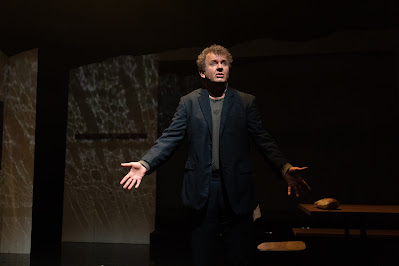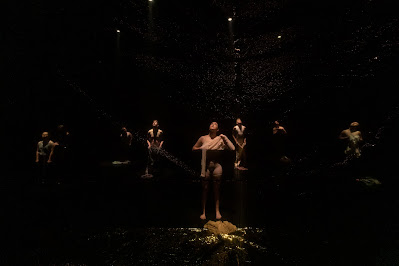WHAT: When The Rain Stops Falling
WHEN: 2 - 18 March 2023
WHERE: Theatre Works
WRITTEN BY: Andrew Bovell
DIRECTED BY: Briony Dunn
SET BY: Greg Clarke
LIGHTING BY: Clare Springett
SOUND BY: Darrin Verhagen
PERFORMED BY: Heather Bolton, Lucy Chaix, Chris Connelly, Francis Greenslade, Darcy Kent, Margaret Mills, and Esther Van Doornum
COSTUMES BY: Betty Auhl
PROJECTIONS BY: Jason Gardham
STAGE MANAGED BY: Kim Davies
 |
| Francis Greenslade - photo by Lachlan Woods |
Few plays speak so directly to our current climate woes than the 2008 Andrew Bovell contemporary epic When The Rain Stops Falling and it is ridiculously on point with the recent flooding of in Alice Springs. Whilst the Iron Lung production currently being presented at Theatre Works has been in the making since 2020, it couldn't have found a better moment in history to be performed than right now. Throughout the play we constantly hear the refrain "Still, there are people drowning in Bangladesh so we shouldn’t complain" in the same way we were brought up hearing about the starving children in India, but to be honest, these days you could easily replace Bangladesh with Lismore...
When The Rain Stops Falling is a play which begins in the future (2039) but weaves and wends its way into a deep past (1959) and forward again to tell its story. This circling of time mirrors the circling of generations and circling of the globe as mistakes are repeated over and over. The despair of repetition is only alleviated by those all so human glimpses of hope for a fresh start. Using an overlay technique in which characters at different times of their lives are occupying the same stage space, we watch sons searching for connections with their fathers, and in turn becoming those very same distant men they were trying to find. This is the true circle of life...
Who knows when the rain started falling? All we know is it hasn't stopped for a very long time. Grey clouds and thunder rend the story at key points to highlight the tension and discomfort of a world eternally grey. The melancholy of the skies reflects the melancholy of the spirits in this bleak world. Fish are extinct and people are isolated by weather, location, state of mind. When The Rain Stops Falling spans a world reaching from London to Perth, from the Nullabor to The Coorong, from Alice Springs to Uluru. And then one day, in the desert centre of Australia where the rain has been falling for such a very long time, a fish falls from the sky.
I need to confess I saw the original production of When The Rain Stops Falling when it played at MTC and I recall saying that it was the best piece of theatre I had ever seen. These are big shoes to fill and I don't think this production does quite meet that standard. Having said that, the cleanness of the Briony Dunn's (director) production allows us to really revel in the writing and reveals detail and nuances in the script with much more clarity, I feel.
Dunn has decided to follow the aesthetic of the original show with a bare and bland Dystopian aesthetic. It is a shame because part of the joy of new presentations of shows comes in seeing new contexts. Having said that, Greg Clarke's set, whilst a touring cliche, does clever things across the top allowing the blackness of the stage space to be not only the looming clouds, but also references the silhouette of Uluru. I kind of wish the projections of Uluru (Jason Gardham) weren't so specific which would have allowed the set to morph the way the play does and add some dynamics to a very geometric space.
Perhaps a lack of dynamics is my biggest problem with this production. Dunn has layered melancholy, disconnection, and greyness over every moment. She lets no life and colour into the show which is a heavy burden for the audience across 2 hours and doesn't really tell the story. There is hope and love and connection in When The Rain Stops Falling, but it is hard to find here. For example when Henry Law (Francis Greenslade) and Elizabeth Law Younger (Esther Van Doornum) appear in their earliest timeline iteration, and when Gabriel Law Older (Darcy Kent) and Gabrielle York Younger (Lucy Chaix) decide to risk a future together, and when a fish falls from the sky... Without those moments of light and connection the true impact of the pain and distance later felt cannot be communicated. Without both this light and shade the true message and impact of the play can also not be conveyed.
The actors were all fantastic and clearly knew what they were doing and why they were there. I particularly enjoyed Chris Connelly's interpretation of Joe Ryan and Heather Bolton, as Gabrielle York Older, was mesmerizing. I got a sense that the cast had been all severely constrained physically - to the point of not being human. There is a movement director credited (Cory Derrick), but they all walk around a bit like zombies and there has been little attempt to connect younger/older versions with any kind of mirrored mannerisms. I think I get the intention, but it creates a sort of visual tedium as a piece of theatre. I saw MOTHERLOD_^E in this same theatre earlier this year and confess to thinking the cast in When The Rain Stops Falling were moving around like The Sims in desperate need of antidepressants. Perhaps that was deliberate...?
Luckily, When The Rain Stops Falling is a play which stands above everything else in the writing alone and Darrin Verhagen's sound design lifts everything it touches (which is the whole play) to a whole new level. Clare Springett's lights bring some nice touches as well.
When the rain stops falling the sun comes out, and it is the dark clouds and wet sky which make that glorious heat and light so refreshing. Andrew Bovell's play, When The Rain Stop Falling, takes us to the darkest and coldest of places so that we are reminded it is our job to find the light and warmth. It is our job to save ourselves and our world, and the way we do it is through change because if we keep doing the same things over and over again, we will get the same results over and over again leading to an inevitable and catastrophic end.
This play is too good to miss despite my luke warm response to some of the technical aspects. When The Rain Stops Falling is a play which should regularly be in the theatre repertoire. It is horror and beauty in the same breath. Life and death in the same heartbeat. Pain and love in the same lifetime. I do want to give a content warning though. The play includes themes of paedophilia and suicide so please consider your triggers and how you might manage them when you buy your tickets.
4 Stars






